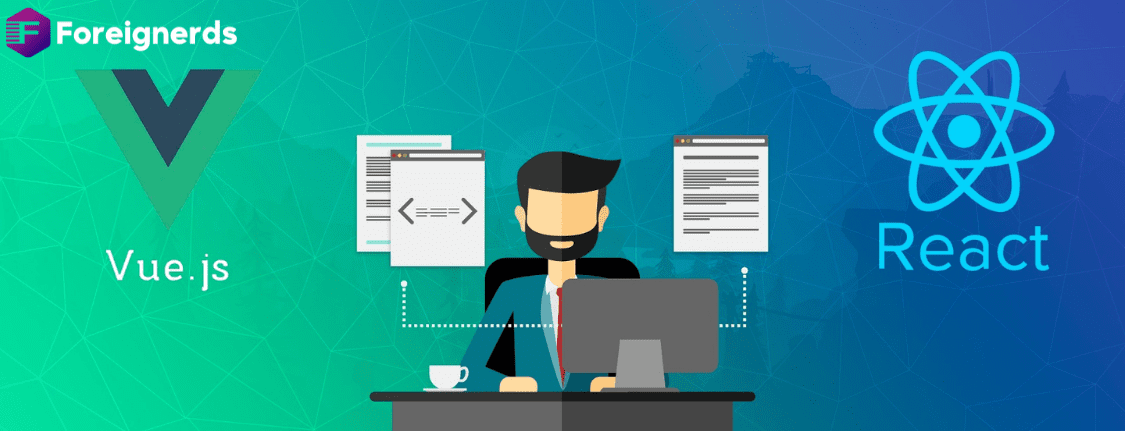- Home
- Design and Development
- React.js vs Knockout.js vs Vue.js: Features...

Selecting the appropriate technology for your web application is a crucial decision that significantly impacts your team’s productivity and the overall capabilities of your project. With the constant emergence of new web frameworks and the transformation of existing ones, it’s essential to make an informed choice.
In this article, we delve into a detailed comparison of three popular JavaScript frameworks: Vue, Knockout, and React. Our focus will be on key features, third-party integrations, and performance to guide you in selecting the ideal framework for your project.
Understanding the learning curve is vital when evaluating a framework. It directly correlates with the time required for the development team to grasp the new technology. In the comparison of Knockout.js, React.js vs Knockout.js vs Vue.js, we observe that all these frameworks have manageable learning curves. However, each presents unique challenges:
Vue, similar to Angular, offers a relatively smoother learning curve. Its documentation is clear, providing a structured understanding of application development. Vue is particularly advantageous for Angular developers, as it shares some similarities.
React, on the other hand, can be challenging initially due to its distinct internal features and component-writing style. However, it boasts a supportive community, as evidenced by its top ranking in the 2022 Stack Overflow Developer Survey.
Knockout poses challenges in building the first application due to the need for custom adapters for third-party libraries. However, its learning curve becomes more manageable once the initial infrastructure code is in place.
Examining the fundamental features of each framework provides valuable insights into their capabilities. When comparing Knockout, Vue, and React, the following distinctions become apparent:
Knockout implements the Model–View–ViewModel (MVVM) pattern and offers basic two-way data binding. However, it lacks support for modern features like routing and lazy loading. The need for extensive use of ko.Observable constructions in code can lead to clutter and potential errors.
Vue adopts the Model–View–Presenter (MVP) pattern, supporting two-way data binding and virtual DOM updates. It excels in providing a clear structure for applications and offers additional functionality through support packages like Vuex and routing.
React focuses on the “View” aspect of MVC and MVVM patterns, providing flexibility in architectural approaches. It employs one-way data binding and virtual DOM updates, with integration options for additional libraries like Redux for state management.
The seamless integration of third-party extensions is a critical aspect of any development framework. To evaluate this, we tested the integration of Bootstrap and Select2 libraries across Knockout, Vue, and React projects:
Both Vue and React exhibit ease of integration with Bootstrap, thanks to available wrappers and package manager support. Knockout, however, requires additional manual code due to its lack of inherent knowledge about Bootstrap.
Vue and React smoothly integrate Select 2, leveraging their compatibility with virtual DOMs. In contrast, Knockout may face challenges with potential event conflicts, necessitating manual control.
Performance is a critical factor in choosing a framework, influencing the responsiveness and efficiency of your web application. In a performance benchmark comparison of Knockout.js, Vue.js, and React.js, the following results were obtained:
| Operation | Knockout | Vue | React |
|---|---|---|---|
| Create rows | 336.7 ms | 180.5 ms | 182.1 ms |
| Replace all rows | 335.8 ms | 157.3 ms | 158.8 ms |
| Partial update of rows | 70.4 ms | 81.9 ms | 156.4 ms |
| Select row | 10.0 ms | 10.3 ms | 10.6 ms |
| Swap rows | 108.6 ms | 106.5 ms | 20.0 ms |
| Remove row | 52.9 ms | 49.6 ms | 54.2 ms |
| Create many rows | 3081 ms | 1935 ms | 1603 ms |
| Append rows to a large table | 3352 ms | 268.6 ms | 342.5 ms |
| Clear rows | 366.7 ms | 175.4 ms | 191.9 ms |
Table source — JS web frameworks benchmark on Stefan Krause’s blog
The performance results highlight that Knockout significantly lags behind Vue and React in various operations. Vue and React exhibit comparable performance, with React showing superiority in specific scenarios.
In the comparison of Knockout.js, Vue.js, and React.js, Knockout emerges as the less favorable choice due to its outdated features, complex code structure, and performance limitations. While suitable for small and straightforward projects, Knockout struggles to keep up with modern development trends.
Choosing between React and Vue depends on various factors, including your development team’s skills. React, with its larger community and maturity, provides extensive support and ready-made solutions. Vue, with its support for two-way data binding and clarity in documentation, is an excellent choice for projects with specific requirements.
Ultimately, the decision hinges on your project’s characteristics and your team’s expertise, ensuring a harmonious match between technology and development goals.
© 2013 - 2024 Foreignerds. All Rights Reserved